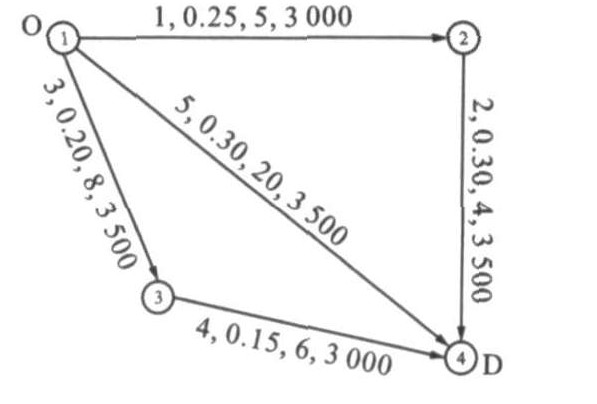Pricing strategy of traffic information under double-objective route guidance system
-
摘要: 为了提高交通信息定价精度, 在假定出行者权衡出行时间和出行费用双目标路径诱导的基础上, 建立混合均衡定价模型, 通过实例对模型进行了标定和验证, 对比评价了单目标和双目标路径诱导下的交通信息定价策略, 并给出双目标路径诱导下的交通信息定价结果。研究结果表明, 与双目标路径诱导相比, 单目标路径诱导改变了交通信息定价的可行区域, 当具有信息的出行者、交通信息提供者、交通管理者三方各自的利益为决策主体时, 交通信息的最终价格分别为1.3、2.6和1.8元, 说明了混合均衡定价模型是有效的。Abstract: In order to improve the precision of traffic information pricing, the travel time and travel cost of traveler were considered, a mixed-equilibrium pricing model of double-objective route guidance was established, the model was estimated and validated with numerical example, the comparative evaluation of the pricing strategies of single-objective and double-objective route guidances was carried out, the pricing result of double-objective route guidance was given. Computation result shows that single-objective route guidance changes the feasible region of traffic information pricing compared with double-objective route guidance, the respective interests of information users, information providers and traffic managers are taken as decision-making hosts separately, the traffic information pricings of the model are respectively 1.3, 2.6 and 1.8 RMB, which indicates that the mixed-equilibrium model is effective.
-
表 1 单目标下三方利益比较
Table 1. Comparison of Er, Baand P under single-objective guidance
区域编号 Er Ba P 1 > 0 > 0 > 0 2 < 0 > 0 > 0 3 > 0 > 0 < 0 4 > 0 < 0 > 0 5 > 0 < 0 < 0 6 < 0 < 0 > 0 7 < 0 < 0 < 0 表 2 双目标下三方利益比较
Table 2. Comparison of Er, Baand P under double-objective guidance
区域编号 Er Ba P 1 > 0 > 0 > 0 2 > 0 > 0 < 0 3 > 0 < 0 < 0 4 < 0 < 0 < 0 5 > 0 < 0 > 0 6 < 0 < 0 > 0 表 3 定价结果
Table 3. Pricing result
Ba/元 Er/% P/元 (M, θ1) Max(Ba) 2.0 2.0 400 (1.3, 0.58) Max(Er) 1.5 2.0 1000 (1.8, 0.63) Max(P) 0.5 0.3 3000 (2.6, 0.09) -
[1] Hong K L, Szeto W Y. A methodology for sustainable traveler information services[J]. Transportation Research: Part B, 2002, 36(2): 113-130. [2] Hong K L, Szeto WY. Modeling advanced traveler information services: static versus dynamic paradigms[J]. Transportation Research: Part B, 2004, 38(6): 495-515. doi: 10.1016/j.trb.2003.06.001 [3] Yang Hai, Meng Qiang. Modeling user adoption of advanced traveler information systems: dymamic evolution and stationary equilibrium[J]. Transportation Research: Part A, 2001, 35(10): 895-912. [4] Yang Hai, Huang Hai-jun. Modeling user adoption of advanced traveler information systems: a control theoretic approach for optimal endogenous growth[J]. Transportation Research: Part C, 2004, 12(3): 193-207. [5] 任刚, 王炜. 基于转向的Logit交通分配算法[J]. 交通运输工程学报, 2005, 5(4): 101-105. http://transport.chd.edu.cn/article/id/200504021Ren Gang, Wang Wei. Turn-based algorithm for Logit traffic assignmen[J]. Journal of Traffic and Transportation Engineering, 2005, 5(4): 101-105. (in Chinese) http://transport.chd.edu.cn/article/id/200504021 [6] 四兵锋, 孙壮志, 赵小梅. 基于随机用户平衡的混合交通网络流量分离模型[J]. 中国公路学报, 2006, 19(1): 93-98. doi: 10.3321/j.issn:1001-7372.2006.01.020Si Bing-feng, Sun Zhuang-zhi, Zhao Xiao-mei. Mixedtraffic network flow-split model based on stochastic user equilibrium[J]. China Journal of Highway and Transport, 2006, 19(1): 93-98. (in Chinese) doi: 10.3321/j.issn:1001-7372.2006.01.020 [7] 李志纯, 黄海军. 多目标路径诱导下平衡市场渗透率的确定[J]. 系统工程理论与实践, 2004, 9(9): 125-130. https://www.cnki.com.cn/Article/CJFDTOTAL-XTLL200409021.htmLi Zhi-chun, Huang Hai-jun. Determination of equilibrium market penetration under multi-criteria route guidance systems[J]. Systems Engineering-theory & Practice, 2004, 9(9): 125-130. (in Chinese) https://www.cnki.com.cn/Article/CJFDTOTAL-XTLL200409021.htm [8] Yang Hai. Multiple equilibrium behavior and advanced traveler information systems with endogenous market penetration[J]. Transportation Research: Part B, 1998, 32(4): 205-218. [9] 张培爱. 互补问题的有效算法研究[D]. 大连: 大连理工大学, 2002. [10] Hong KL, Szeto WY. Acell-based variational inequality formulation of the dynamic user optimal assignment problem[J]. Transportation Research: Part B, 2002, 36(5): 421-443. -





 下载:
下载:












